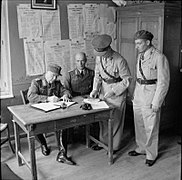Otto Wagener's Human Design Chart
2/5 Emotional Manifesting GeneratorGerman Nazi major general and, for a period, Adolf Hitler’s economic advisor and confidant.
In 1916 during the First World War, Wagener was promoted to the General Staff. After the war, Wagener was involved in the planning of an attack against the city of Posen (now Pozna?, in Poland), but had to flee to the Baltic countries to avoid arrest. There he merged all Freikorps associations into the German Legion, and assumed leadership after its leader, Paul Siewert, was murdered. After returning to Germany, he was active in Freikorps operations in Upper Silesia, Saxony, and the Ruhr area.
In 1920 he studied economics and managed to broaden his knowledge by travelling abroad. In 1929 Wagener joined the National Socialist German Workers’ Party and the Sturmabteilung, having been recruited by his old Freikorps comrade Franz Pfeffer von Salomon. Wagener was able to put his business acumen and contacts to good usage for the National Socialists.
He functioned as SA Chief of Staff from October 1929 through December 1930, assuming effective command of the SA for a few months in the wake of the Stennes Revolt until the assumption of command by Ernst Röhm as the new Chief of Staff in early January 1931. In 1933 he became a member of the Reichstag.
In January 1931, Wagener led the Political-economic Department of the NSDAP, and in September 1932 he was appointed the Führer’s personal economic advisor. Hitler appointed him Reich Commissar for the Economy from April to June 1933.
Internal conflicts led to legal proceedings against Wagener in 1933 and 1934 in a case brought before the USCHLA (Party tribunal). After the Night of the Long Knives, Wagener was detained for a short time. Nevertheless, he was rehabilitated, and he resumed his career in the army.
In the Second World War, Wagener served at the front, rising to the rank of major general and becoming a division commander. After the war, Wagener found himself first in British and later, from 1947 to 1952, Italian prisoner of war camps.
In 1946, while being held by the British, Wagener wrote his memoirs about Hitler and the NSDAP’s early history, entitled Hitler aus nächster Nähe. Aufzeichnungen eines Vertrauten 1929?1932 (known in English as Hitler: Memoirs of a Confidant). His work was not published until seven years after his death, in 1978. His memoirs are used, to some degree, by Third Reich historians.
Otto Wagener died in Chieming on 9 August 1971, aged 83.
Link to Wikipedia biography
Discover More Famous People
Browse and analyze over 55,000 public figures and celebrities.
Ra Uru Hu
5/1 Manifestor
Martha Stewart
4/6 Manifestor
David Lynch
4/6 Generator
Barack Obama
6/2 Projector
Steve Jobs
6/3 Generator
Vladimir Putin
5/1 Manifestor
Michael Jackson
1/3 Projector
Kim Kardashian
3/5 Generator
Marilyn Monroe
6/2 Projector
Ariana Grande
2/4 Projector
Oprah Winfrey
2/4 Generator
Johnny Depp
2/4 ManifestorWhat is HumanDesign.ai and how does it work?
Curious what makes Otto Wagener tick? HumanDesign.ai instantly maps their exact birth data into a fully interactive clickable bodygraph chart, letting you hover or tap every center, channel, and gate for plain-language explanations. Bella, the platform’s built-in AI guide, adds context in real time, translating complex mechanics into everyday insights so you can see how Otto Wagener’s strengths, challenges, and life themes play out on-screen.
The same tools are waiting for you. Generate your own Human Design Chart in seconds, open a library of 2000+ suggested questions, and chat with Bella as often as you like to decode your design, daily transits, and even relationship dynamics.
Want to compare energies? Save unlimited charts for friends, family, or clients, then ask Bella to reveal compatibilities, composite patterns, or coaching tips, all in one conversation thread.
Start free with core features, or unlock our Personal and Pro plans for deeper dives: unlimited Q&A, celebrity chart search spanning 55,000+ public figures, white-label PDF reports, branded content generation, and a professional profile with built-in booking for practitioners. Whether you’re exploring your own potential or guiding others, HumanDesign.ai delivers an ever-expanding toolbox of AI-powered insights—no spreadsheets, no jargon, just clarity at your fingertips.
Ready to see yours? Signup for FREE today!

